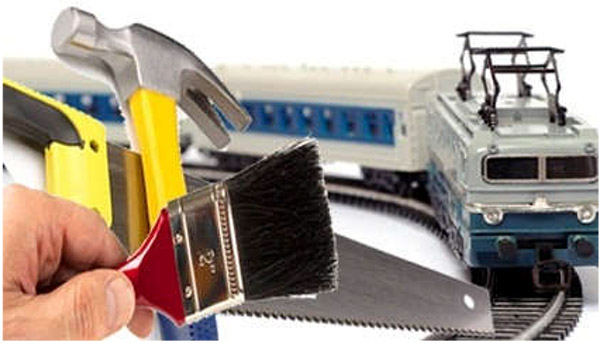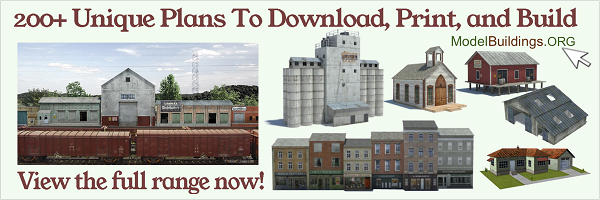Start Building the Tool Kit Ready for Efficient Layout Construction and Maintenance
With an interesting and viable plan in mind, it’s time to look at how to get going. Regardless of what construction method you choose, there are some basic items that you will need for your entire modeling career.
Benchwork to hold the layout will require a small assortment of woodworking tools. Some small and medium sized woodworking clamps will come in handy. A good quality measuring tape, a small square, a bubble level, a hand or light duty electric circular saw to cut lumber, a claw hammer, a 1/4” electric drill and a an electric screwdriver or cordless drill with screwdriver bits round out the necessary items.
Every artist has a set of tools that he has acquired over the years. As you progress in modeling, you will learn or discover your own preferred array of helpful items. Many are traditional tools such as screwdriv-ers, but you will also find that tools and utensils from many sources will make modeling easier or more con-venient. For example, paintbrushes are not only useful for spreading paint, but they can be used for dust-ing equipment, spreading ballast, or arranging ground cover. Dental tools of all sorts are great for sculpt-ing plaster features. © Copyright http://www.modelbuildings.org All rights reserved.
For the beginner, some tools might already be around the house. A regular claw hammer, a tack hammer, #1 Phillips and 1/8” flat screwdrivers, and a pair of pliers are commonly found in the homeowners’ or handyman’s tool box. Basic enhancements for the beginner should include a small pair of wire cutters, a fine-point needle nose pliers, a set of miniature screwdrivers in flat blade and Phillips types, a steel ruler, and a small vacuum vise or third-hand tool will be most useful. Also essential are X-acto knives and blades. Most modelers start with a #1 knife handle with a #11 blade for fine work and a #2 handle and #2 blade for heavier cutting. The #5 handle is also useful, as it can be used for a file handle and has a nice fine-toothed zip saw available as well as being a knife handle. There is a set of all three knives and blade assortment available for about $17 USD, which with care will last a lifetime of modeling. At some point, you might be doing kitbashing or scratch construction. When you do that, you’ll need a scale ruler which will make it easy to cut parts to the right scale size without doing a lot of math in your head.
Small tweezers with curved blades make handling tiny parts much easier, and having a lighted head mag-nifier will help you guide the parts into position. Let’s not forget a nice strong work light as well. Although lighted magnifier lamps can be a bit pricey, they are most helpful in nearly every situation requiring fine detail work.
There are two other modeling tools that you’ll also need. When you get around to laying track for your layout, a Xuron XUR-2175B track cutter is indispensable, as it makes quick work of fitting track to length. Xuron is a high quality manufacturer and makes a very broad line of other types of pliers which have an excellent repu-tation.
Many of the same tools can be used when constructing buildings and structures from card, balsa wood, plastic, or corflute. Downloading plans like the range on this website are the preferred choice for many in the hobby due to the realism of the HO/OO, and N scale plans, the sturdiness of the models when constructed, and low price compared to plastic models which still require skilled painting, weathering, and air-brushing to remove to plastic look.
Track sections and electrical connections should also be soldered together, which will require a 30-watt soldering iron and rosin core solder. Soldering is a skill to be mastered, and there are many YouTube videos available to demonstrate proper technique for both model railroading and general electrical and electronic projects.
Spring clothespins make excellent small clamps. Attaching several of them to a small scrap of plywood is a fine way to hold larger sheets of material for cutting or other work. Similarly, paper clamps and other office supplies can be re-purposed into the tool drawer to help with holding or positioning parts.
Poor quality tools will repay your investment with poor work and possible injury. Fine quality tools for mod-eling are relatively inexpensive, so buy quality whenever you can. Micro-Mark is an excellent source for modeling and hobby tools and other items if your local hobby store can’t supply them.




